The post-Olympic period showed us a lot of good performances and some World Records, above all in breaststroke. Some athletes improved a lot reaching the world top level while someone else was not in a good shape. In all this something or better someone important is missing: Adam Peaty.
It is difficult to speak about breaststroke without mentioning Adam Peaty.
To fill this gap, I compared Peaty’s World record in men’s 100m breaststroke at 2019 World Championship with the same race at Tokyo Olympic Games. In Japan, Peaty won the gold medal with a bit slower result. It was a difference of just about half second.
Nothing so strange but the fact is that we are used to seeing Peaty performing at his top level.
Mechanical differences between the two performances
In this article I would like to focus the attention only on the mechanical differences between the two performances, and there will surely be several issues to be considered. No doubt the pandemic has affected the possibility to train as usual. Moreover, we have to remember that all the races at the Olympics took place in the morning, which is not the best moment to perform in broad strokes.
The World Record was set at the Gwangju 2019 World Championships with a time of 56.88 while the result at Olympic Games was 57.37. The difference is of 0.49 seconds.
RACE PHASES
A little bit of a deeper analysis shows us some more interesting factors:
The start time at 15m was almost the same in Tokyo and Gwangju. Swimming phase of the first 50m, from 15m to 50m, was 0.15 sec faster in Gwangju than Tokyo. This finding in consistent with the difference between the time of the first 50m.
UNDERWATER PHASE
If you consider Adam Peaty’s performance, it is easy to think that the underwater phase is usually his weakness. In Tokyo, however, he showed significant improvement in the first 15m after the turn. The turn, the underwater, the breakout and the first strokes: 0.22 sec better in Tokyo than Gwangju in just 15m.
This is an astonishing improvement. Peaty and his coaches must have worked hard on this point!
The improvement is equally spread from the wall to 15m. This point is very interesting: as we can see in the report, at 65m Adam Peaty was 0.13 sec faster at Olympics.
From 65m to 100m the report shows the slowest part of the race: at Olympics Peaty swam 0.61 sec slower than World Championships in just 35m.
As we have previously stated, there are several reasons which make a comparison between the World Record in Korea and the Olympic final very difficult: above all the pandemic season and then the morning schedule for the finals.
STROKE RATE/DISTANCE PER STROKE
Checking the evolution of the stroke rate (or stroke tempo) and the distance per stroke, we see:
- FIRST 50 M: the stroke rate at Olympics is just a bit slower: 54.3 at OG and 55.9 at WC
- DISTANCE PER STROKE. It isn’t very different: 188.4 at OG vs 184.7 at WC.
- SECOND 50m. The stroke rate is a bit faster at OG than World Champ: 59.2 vs 57.8
- DISTANCE PER STROKE. It’s shorter in the second 50m: 160.2cm at OG vs 167.7cm at WC, with 7.5cm less on average than World Champ.
If we check the same parameters at the end of the second 50m – from 85m to 95m – we can see that the difference is much higher. However not as regards the stroke rate which is almost the same: 58.3 at Olympics and 57.9 at WC. The difference in the distance per stroke: 168cm at WC and 157,5cm at Olympics. A difference of 10.5cm is quite a lot.
This is the key point!
SWIMMING COORDINATION
In one of my previous articles, I have already analyzed Peaty’s world record and above all his swimming coordination (click here to read more).
If we do the same for the Olympic Games and we compare the data, we can see something interesting. At same point we notice the great difference in the time gap and in the distance per stroke.
In my coordination analysis I timed every phase of the pull and kick, synchronize both data and highlighted the sync between kick and pull.
Those data are the average of the three cycles in the second 25m of every 50m, from 35m to 45m.
What mostly impressed in Peaty’s performance at World Champ was his ability to modulate the coordination according to the different stroke rates.
We can see that Peaty anticipates the kick action when he increases the stroke rate.
With this action Peaty is able to keep gliding also when the stroke rate is high. The gliding time is the time between the end of the kick and the beginning of next pull.
what makes the difference
With few exceptions, breaststroker usually cut the passive phases of the swimming cycle in order to increase the stroke rate. This strategy works up to a certain point. The passive phase is when the swimmer glides on the water and if this phase equals zero the gliding tends towards zero and the body moves forward just, or mostly, during the active pushing movements.
One of Peaty’s strengths is the ability to modulate the coordination between pull and kick.
2019 WORLD RECORD PERFORMANCE
The higher the stroke rate is, the more he is able to anticipate the kick in order to keep both the passive phase and the gliding unchanged.
This is what he showed us in Korea: amazing!
From the graph it is possible to clearly see the difference between the first and the second 50m.
If we use the end of the arm recovery as a reference point, we can see that in the second 50m he is kicking earlier than in the first one.
TOKYO OLYMPIC PERFORMANCE
In the Olympics we can see that in the first 50m the coordination is very similar to the coordination at the World Champ.
Also the kick timing and almost all the other parameters are the same; just the arm recovery time is longer.
In Gwangju the arm recovery was one of Peaty’s strongest points and what actually marked the difference from all the other swimmers.
If we check the coordination in the second 50m, precisely from 85m to 95m, we can see that the pull action coincides perfectly with the World Record, but in the kick action the difference is huge.
The leg recovery and the propulsive kick are slower, and the passive phase is faster. What’s more, at Olympics Peaty doesn’t change the coordination pull/kick from the first to the second 50m, when the stroke rate increases.
The result of this dynamic is that the gliding is shorter if compared to the performance for the World record and the same applies to the distance per stroke… and the speed.
Conclusion
According to Adam Peaty’s own statement, he is preparing something new for the future. We have witnessed an important improvement in his main weakness: the underwater phase. We have also observed an important difference in the intracycle coordination and in the final result. Once again, it is important to remember that the pandemic season and the morning schedule of the finals at Olympics created a very particular background.
This is just the mechanical analysis. It would surely be very interesting to understand and study the reason of all these differences.
VIDEO COMPARISON
courtesy of STEFANO NURRA on YouTube
This story comes courtesy of STEFANO NURRA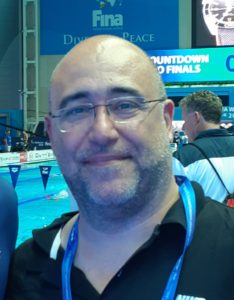
- Analyst of Turkish Swimming Federation
- Analyst of Energy Standard



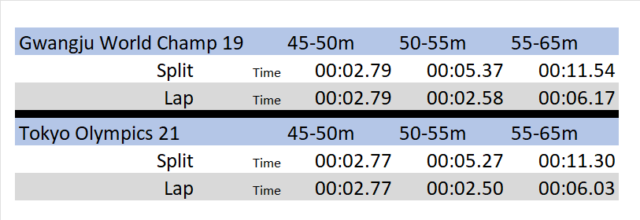


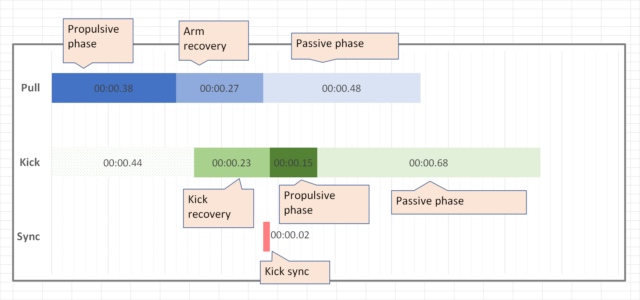
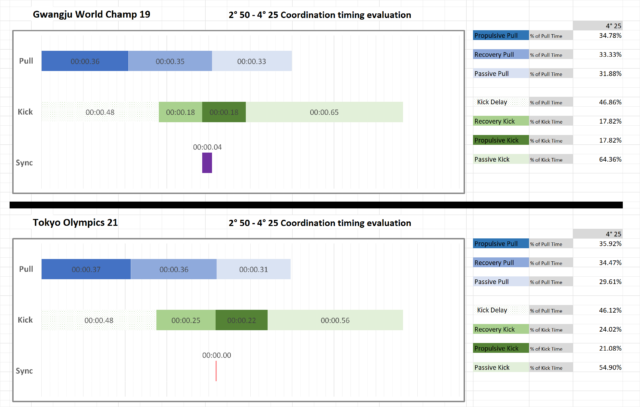
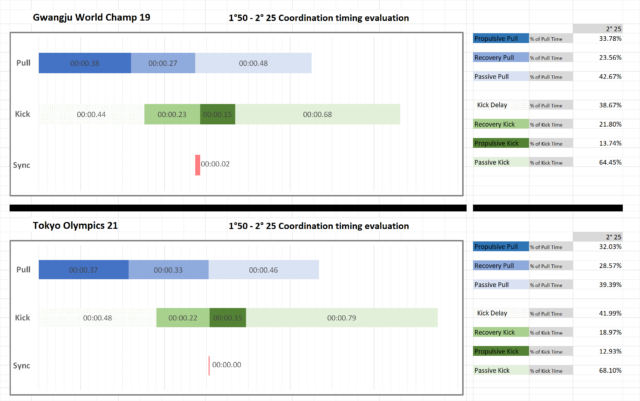
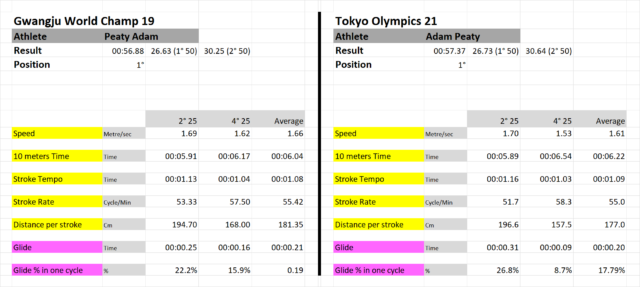
Excellent analysis! Really enjoyed this one.
These nit-picky, analytical deep dive (no pun intended) articles are always so cool.
If Peaty cuts back on his muscle mass and incorporates 200m training, he has a shot at dropping another WR.
Kamminga and Nicolo have a huge potential to improve. I think Peaty already went his best time in 2019.
100 m sprinters go their best time normally in the early 20s. (Between 22 and 26)
You said he is preparing smth new for the future, you need to understand that his project is just a marketing for his book.
Nonsense.
Great article.